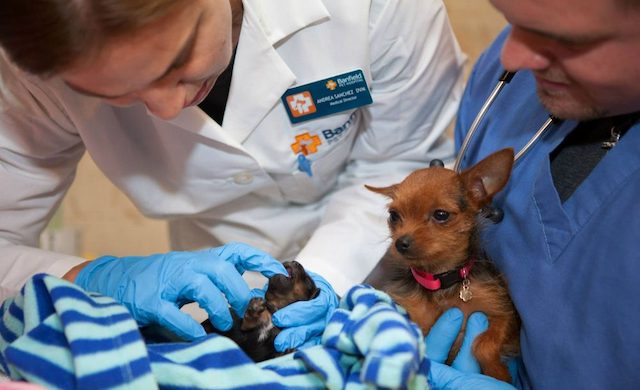
When You Love What You Do, Your Work Becomes a Mission
11/14/2018 01:00AM | 4262 viewsAndrea Sanchez was eight years old when she got her first cat, Tabitha.
After just a few months, she already loved Tabitha so much she decided she wanted to be able to give back to pets for the rest of her life.
Dr. Sanchez has lived up to that early dream. Not only has she worked in the veterinary medical industry for nearly two decades, but she also takes her skills and dedication on the road – traveling to places where people and pets are in need, often after a natural disaster, so she can lend her expertise and extend a helping hand.
That early spark was confirmed for her when she was an undergraduate student at Vassar College. One day as she was walking out of biology class she remembers thinking: “Man, I’ve always loved this stuff – life sciences, cellular material, DNA. Living things are so amazing.”
She describes that thought process as a confirmation that her eight-year-old self was exactly right: “That’s it: I love animals, I love biology, I’m going to be a veterinarian.”
That afternoon, she walked into her career guidance office and asked: “What do I have to do to get into veterinary school?”
After she earned her bachelor’s degree in biology from Vassar, she completed her four years of veterinary schooling at Oregon State University, where she earned her doctor of veterinary medicine (DVM) degree in small/companion animal surgery and medicine.
But it wasn’t necessarily an easy road.
Preparing for Vet School
Based on her own experiences, Dr. Sanchez offers advice for anyone interested in veterinary medicine.
- While working toward your undergraduate degree (or even while you’re still in high school), take all the math and science classes you can – especially life sciences, organic chemistry and molecular biology.
- Before your freshman year of college, find some veterinary schools you might be interested in, and look on their websites for their list of prerequisite courses. It can be possible to complete prerequisite courses as part of your undergraduate degree.
- Once you reach junior and senior year of college, start applying to veterinary schools.
Dr. Sanchez made sure to follow up that last statement with some encouragement: “Apply to more than one veterinary school. It’s highly competitive, so you may not get in the first time you try. But don’t get discouraged! Many people apply at least two times before they get in. That’s normal – stick with it if you really want it.”
She knows what she’s talking about. In fact, she didn’t get in on her first try. She was told she didn’t have enough clinical experience.
But she took her own advice and found a way to rectify that, and ultimately was accepted into Oregon State University College of Veterinary Medicine.
Getting Clinical Experience
To gain experience that helped her candidacy for veterinary school, she spent a full year working in a veterinary clinic.
Most veterinary hospitals will hire pet-loving people to support veterinarians and veterinary technicians. “That’s a great way to get the experience you need, and also to make sure this is a career path that you will genuinely enjoy,” she said.
Dr. Sanchez’s first job involved cleaning kennels. After a while, she moved up to receptionist.
“I learned so much about veterinary medicine in those jobs,” she said. “Those roles helped me even more than being a veterinary technician.”
She recommends finding a practice that has a good training program, like one of Banfield’s Student Job Programs for veterinary students. Show them you’re ready to work hard, take any role they’ll give you, and commit to learning everything you can.
She also encourages people to volunteer at an animal-focused nonprofit or shelter. You can walk the dogs, clean kennels, any number of activities that will give you even more experience. Some of them provide free pet care to low-income community members.
“Volunteering can give you great experiences,” she said.
That’s probably why she still spends so much of her time giving back to people and pets in need.
Dr. Sanchez volunteers to provide wellness care to pets in need through several activities and organizations.
She sits on the grant selection committee of the Banfield Better Together Fund, which provides support to Banfield associates after natural disasters. She is also on the board for Portland Animal Welfare (PAW) Team, an organization in Portland, Oregon, that provides free veterinary care to the pets of people who are homeless or living in poverty.
After natural disasters like hurricanes or wildfires, thousands of pets can end up stranded and in need of care. Animal shelters often suffer damage or are destroyed, and can lack resources to repair or rebuild. Banfield (and its parent company, Mars, Inc.) steps in with volunteers and resources. In 2018, Banfield volunteer activities had an impact on thousands of pets and people through volunteer programs, disaster relief and Banfield Foundation grants.
Dr. Sanchez plays an active role in that work. Check out this video to see her and the Banfield team in action.
With training in veterinary medicine, there are so many different ways to help pets and people. Dr. Sanchez is living up to her childhood goal of dedicating her life to helping others like her first cat, Tabitha.
And she takes special pride in the name “Dr. Sanchez.” Her grandfather was the first Dr. Sanchez in her family – “a human doctor,” as she described him. “He really gave us that appreciation of the power and beauty of medicine.”
She faithfully honors the family tradition of passing that appreciation for medicine on to others.






Post your Comment
Please login or sign up to comment
Comments